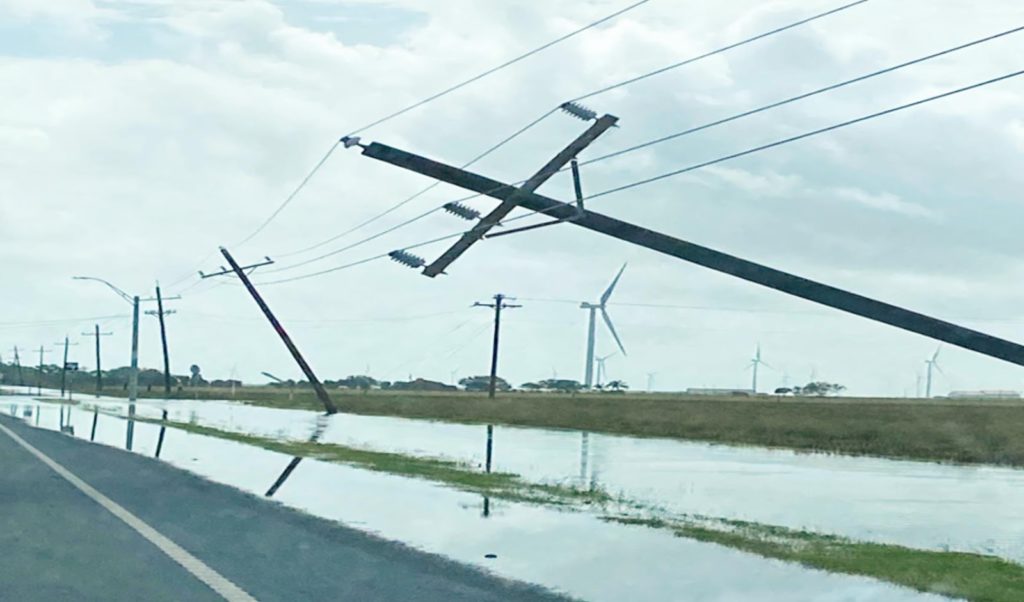
Omar E. Zapata | THE RIDER
The Rio Grande Valley, with an influx of COVID-19 cases and deaths, now has to deal with the first hurricane since 2008 and its aftermath.
Hurricane Hanna marked the first time in 12 years that a hurricane made direct landfall in the RGV since Hurricane Dolly. Starting off as a tropical storm on July 23, Hanna strengthened into a category one hurricane on July 25 according to the National Weather Service.
Ricardo Saldaña, emergency management coordinator for Hidalgo County said that shelter during the hurricane was the biggest concern.
“We had to make significant adjustments to what we were used to doing in a shelter before,” he said.
With the help of the American Red Cross, their shelters had to follow COVID-19 protocols Saldaña said.
“Then we had to deal with the flooding and accessibility to the hospital emergency rooms,” he said.
Individuals that might have fallen ill due to COVID-19 during the hurricane had to wait till after to be transported to the hospital due to wind conditions and flooding around hospitals, Saldaña said.
Peak wind speeds in the RGV ranged from 55 to 80 mph according to the National Weather Service.
Another situation that COVID-19 made tricky was rescuing residents from flooded areas.
“Individuals (that) did not have facial coverings and things of that nature, we would provide them while we transported them to a safe haven,” he said.
There was 8 to 15 inches of rainfall throughout the RGV according to the National Weather Service with eastern parts of the Valley receiving significant flooding.
“So the most impacted water event that we had was in the eastern part [of the county],” Saldaña said.
When all the drainage systems filled with water and started moving east, it caused the drainage system to back up and overflow, causing those areas to flood, he said.
Saldaña said the county currently has flood control projects and have been working diligently on trying to make adjustments and corrections to the drainage system.
“Our leadership realized that there was an issue back from the 2018 floods, so they have already taken on many drainage improvement projects throughout the county,” Saldaña said.
Currently Hidalgo County is assessing the damages caused by Hanna to see if they qualify for help from the Federal Emergency Management Agency (FEMA).
The county has to meet a threshold of $3 million in damages and 800 destroyed or majorly damaged homes to even be considered he said.
Fernando Alvarez, a mechanical engineering senior, said this was his first experience with a hurricane. Having moved to the Valley in 2017 from his home country of Peru, Alvarez admits he was a bit scared during the hurricane.
“It was pretty crazy … I was just on edge,” he said. “I had no idea if the house was going to flood.”
Water was close to entering his home, but luckily the only damages were trees and fences being knocked down.
“You would see the street flooding and then we were completely unconnected from the world because we had no electricity,” Alvarez said.
He and his family were without electricity for four days and this caused a problem with his mother having a condition that flares up when it is too hot.
Luis Reyes, communications manager for Magic Valley Electric Cooperative (MVEC), confirmed that at its peak, 85,000 members were without power, which is 68% of its customers.
Lee Jones, community affairs manager for American Electric Power Texas (AEP Texas), said that 152,000 of its RGV customers were without power, which is 47% of their total membership in the RGV.
Jones said flooding and lack of manpower were the biggest issues faced after the hurricane to restore power, which resulted in AEP Texas bringing 1,500 outside crews to help with restoration.
MVEC had a 95% restoration on Aug. 29 and AEP Texas had it on Aug. 31.
“The stronger the storm, the more severe it’s going to be but what helped a lot was a lot of reporting everything online through the outage system,” Reyes said.
Saldaña said to make sure prior to a hurricane or storm passing through the RGV, to clear up your yard, cut any trees that might pose a threat to your property and patch up any roof damage to prevent water leaking through.
During a storm or hurricane, he said to make sure you have proper documentation ready to go, have water, food, and medication for seven days, make sure you have money on hand and your car is full of gas to evacuate, if needed.
When asked what he will do next time in preparation, Alvarez said he will invest in buying a generator.
Saldaña said he thinks generators are a good idea, but have to be used cautiously due to carbon monoxide.
“They need to be in an area where it’s well ventilated and where the exhaust fumes can be dispersed naturally,” he said.
Four out of five members of an Edinburg family died from carbon monoxide poisoning due to a generator being inside a home in the aftermath of the hurricane, according to local officials.
“While we’re dealing with this pandemic in the Rio Grande Valley you never know when we will be struck by either a natural event like a hurricane, a flooding or a man made event, you know. Similar to what happened in Lebanon with that port that had that explosion, you never know,” Saldaña said.

Hanna’s damage to UTRGV
Richard Costello, director of Environmental Health, Safety & Risk Management told The Rider that UTRGV is probably looking at $3 to $4 million in damages.
“We had a few buildings that got flooded,” he said. “We had other buildings that got some water damage … all along it could have been worse.”
Costello said the Edinburg campus took most of the damage while the other campuses had very minimal damage that just adds up.
The UTRGV baseball field is probably the biggest issue because of all the water that got into it, he said.
“The field is very sensitive … you got the turf that has to be maintained now that it’s flooded, it’s probably gonna have to be completely replaced,” Costello said.
UTRGV has an emergency response plan when there is a hurricane and an incident command team that met prior to make sure they were prepared for it.
“We were caught off guard because the hurricane was not supposed to impact the campus the way it did,” he said.
With the Edinburg campus being prone to flooding the last several years, The Rider asked Costello what could be done about this.
Costello replied, “All the counties to coordinate one strategy, one effort into draining the Valley.”
He also says fixing the drainage issue is difficult since the Valley just doesn’t have enough drainage for significant rain.
“So until a Valley-wide effort is made, and that may take a long time, we’re going to continue to have these problems,” he said. “If we have a category two or category three hurricane with a significant amount of water, we can be in serious trouble.”
Rio Grande Valley Mutual Aid
A collective of organizers and volunteers from the RGV have stepped up and created a mutual aid fund to help those in need due to the aftermath of Hurricane Hanna.
Denisce Palacios, a political science senior and organizer for the Rio Grande Valley Mutual Aid, said what started off as a handful of people has turned into 40 to 45 people coming in and wanting to help those in need.
“Because we’re a border community we’re often dismissed,” she said. “So, it was something that had to happen, because otherwise who would help us?”
Palacios said one thing that rallied organizers together to create this fund was that a meteorologist from ABC’s “Good Morning America” said the hurricane is hitting a good spot with not a lot of population there. The spot was the RGV.
With the Valley’s large undocumented population, Palacios said people may not be able to get assistance from FEMA.
RGV Mutual Aid has raised over $45,000 for those in need and has already disbursed $14,383.
Some of the things the money is going toward are property damage, hotel expenses, medication, baby supplies and loss of work.
“We’re just trying to help as many people as possible that were affected by Hurricane Hanna in the middle of a health pandemic, but we have over $442,000 in aid requests and we have over 500 requests,” Palacios said.
She said listening to all the stories about what people have had to go through is heartbreaking.
The group has indefinitely closed their application for aid requests due to the sheer number of applicants.
“The way that we’re dispersing funds is through … like actual cash because we know a lot of undocumented people don’t have bank accounts,” Palacios said.
She said people are doing various things to help donate and bring awareness to the mutual aid. People are selling their clothes, doing concerts online, baking and even weightlifting to bring funds and attention to it.
Palacios said the overall community response has been positive and encourages people to donate as much as they can.
“Know this fund is based in love,” she said. “It’s based in love for our community.”
For more information visit @rgvmutualaid on Instagram or Twitter for updates. To donate visit tinyurl.com/rgvmutualaid







